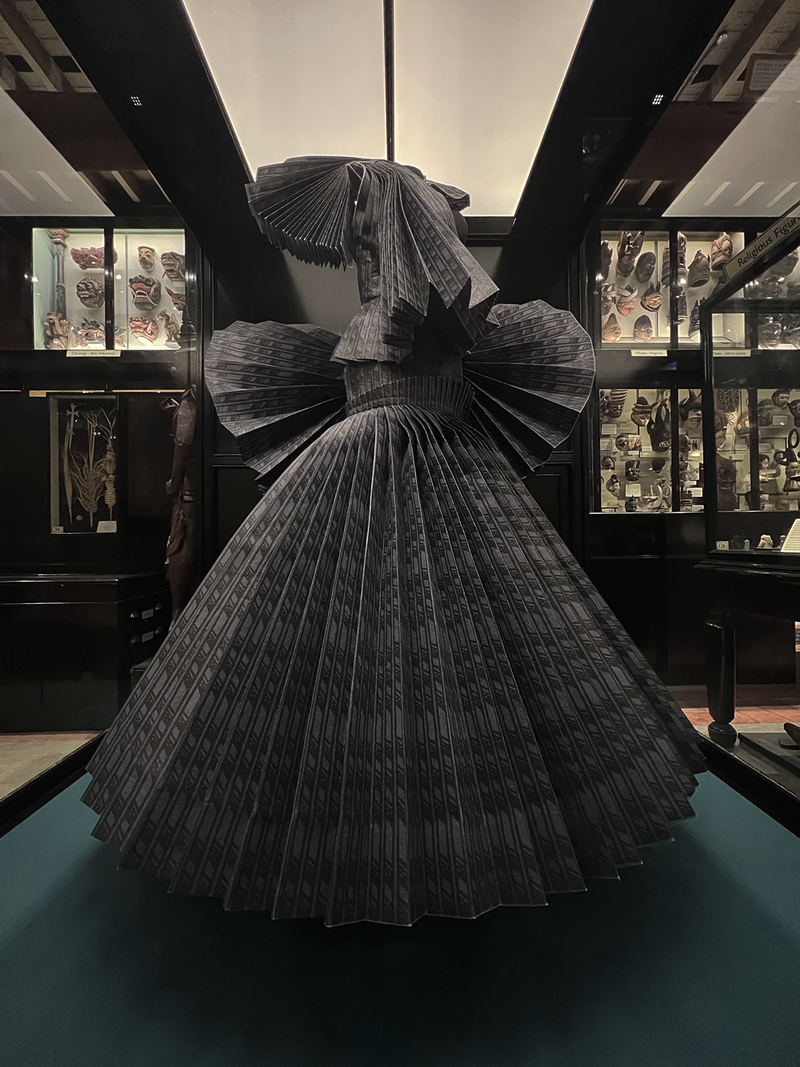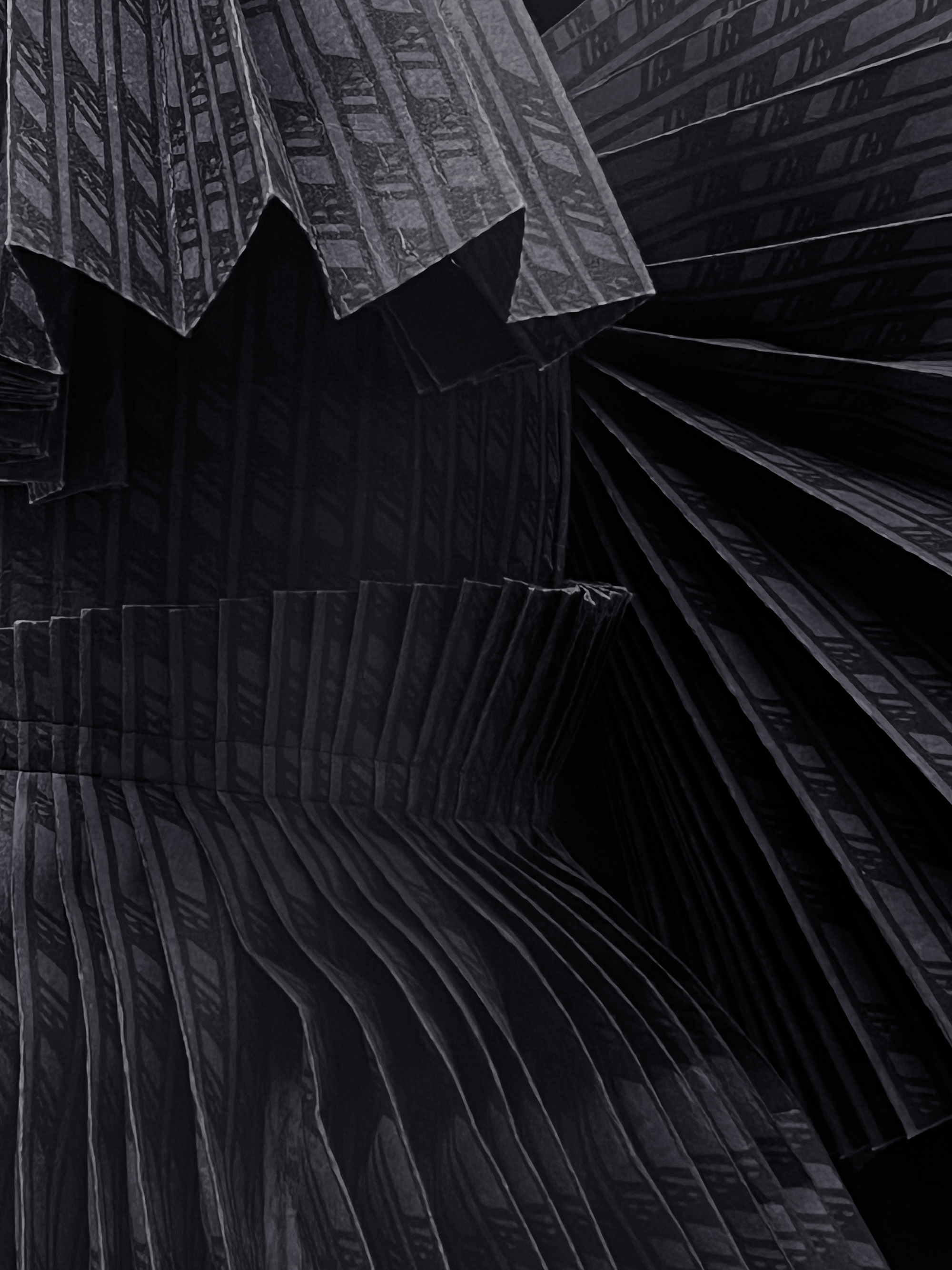Hulu Nēnē
Discover the beautifully sculptural Hulu Nēnē dress by fashion icon Manaola Yap, a designer and cultural practitioner from Hawaiʻi, within the Pitt Rivers Museum galleries.
Displayed in a case in near the centre of the museum court on the ground floor, this installation is part of the journey through the Hawaiian landscape offered through the museum's current special exhibition Hawaii: Ma uk to Ma kai.
Through the special collection of their designs, Manaola honors and pays homage to the great warrior chief, Kamehameha, Pai`ea. Born on Hawai`i Island in secrecy and taken to safety by a swift runner to the high cliffs of `Awini Kohala, the infant king was hidden in the caves to escape the order of Alapa`i Nui that the infant be put to death. The Designer gains his inspiration from ancestral chants, and stories speaking of the youthful years of the royal child.

Hulu Nēnē By MANAOLA on display in the Pitt Rivers Museum
In Hulu Nēnē (Hawaiian Goose Feathers), Manaola embraces the traditional sayings of our ancient ones – “`O nā kānaka Hawai`i, he po`e make`e haku, he po`e nēnē `ili kapu,” the Hawaiian people are people who cherish their lords, people constantly thinking of the sacred skin [of chiefs].“ (Mary K. Puku`i). Thus, the feathers of this noble bird represent the sacred covering of royalty. Such poetry is found in the oli chant “Mehe hulu Nēnē la ka haki manawa o ka pali e kū nei” meaning “Like a goose feather, the child was plucked from the arms of his mother and taken to the sheer cliffs.” Manaola uses the imagery of repetitious patterns found in the Nēnē goose feathers to depict the separation of children who are being weaned from parents. It is a print of independence and courage for our youth. In the evolution of life, a child must walk on his or her own to learn and to have the strength and will to embrace his or her greatness.
For the Designer, the Hulu Nēnē also represents what a mother will do to protect her child. A mother’s love and their vigilance in protecting their babies from harm is part of a mother’s innate nature. This protective instinct is depicted through the imagery of the humble Nēnē bird. The Hulu Nēnē pattern is symbolic of protection in its most intense quality. At times, we are called upon to sacrifice for a higher good or purpose to achieve the potential which has been bestowed upon us.

Hulu Nēnē By MANAOLA
Who is Manaola Yap?
Aloha. My name is Manaola Yap and I am a cultural practitioner from Hawaiʻi. In my ohana (family) we are all hula dancers, chanters, musicians and artists in really our indigenous way of storytelling or sharing mo‘olelo. These are stories of our past, stories that embed our connectivity to our environment, to each other.
My medium in a contemporary space is the medium of fashion. I use my traditional roots and background in storytelling and translate that into new mediums that are relevant to popular culture right now. And that medium that I like to share with the world is our Hawaiian culture through fashion.
What Hawaiian practice is reflected in the Hulu Nēnē dress?
The pattern on the dress is created through a practice called ohe kāpala, a form of traditional bamboo stamping. These are made by carving intricate patterns into bamboo sticks. Each pattern represents a repetition design found in nature. Repetition is important because it represents the rituals, the practices, the hours of sacrifice that artisans make to be able to create.
What does the Hule Nēnē pattern mean?
The specific stamp that I chose to use in this piece is called the Hulu Nēnē. Hulu means feather and nēne is the Hawaiian goose. When we talk about the hulu nēnē, we are actually speaking about the skin of our chiefs. It refers to the saying ʻO nā kānaka Hawai`i, he po`e make`e haku, he po`e nēnē `ili kapu’/ ‘the Hawaiian people are people who cherish their lords, people constantly thinking of the sacred skin [of chiefs].’
Our ancestors choose the nēnē-a goose because the nenē is low to the land. A chief is a living god on earth and is meant to help to sustain the land and all its people, animals and nature. Which is why I believe our ancestors chose the nēnē as a representation of the skin of chiefs.
The pleats and the spiralling of the skirt, is a representation of the ‘ie‘ie, which is a native Hawaiian plant that is a kinoalu (a physical plant embodiment) of some of our deities. The ‘ie‘ie represents the spiral of knowledge, the plant itself climbs and wraps around the under-storey of our native ‘ōhi‘a tree.
What does the Hule Nēnē dress mean to you?
Our native indigenous arts are born from ancestral knowledge, and allows us to leave a legacy, is to make sure that the future generations have that connectivity and understand that our roots grow strong. And to know that with that wisdom and knowledge that you can do absolutely anything. So really, this piece is a contemporary expression of ceremonial dress but also the movement of culture and arts into the future. Aloha.




